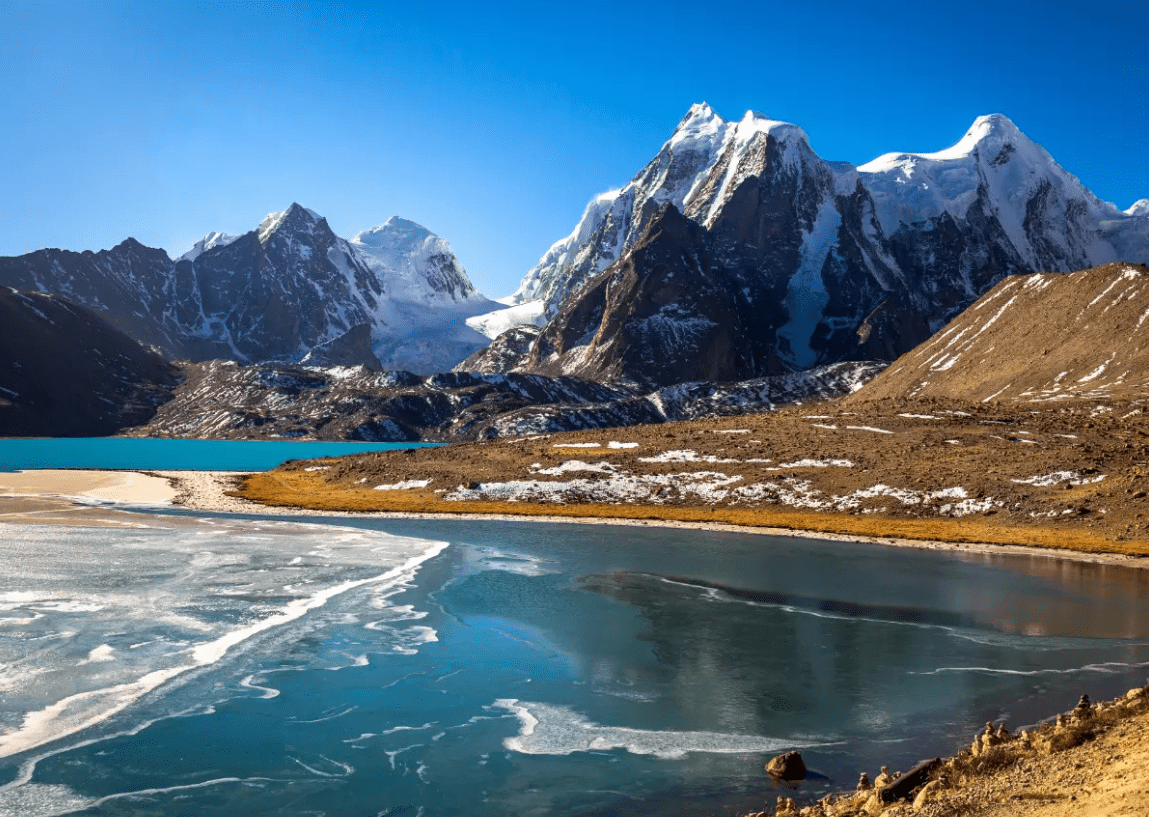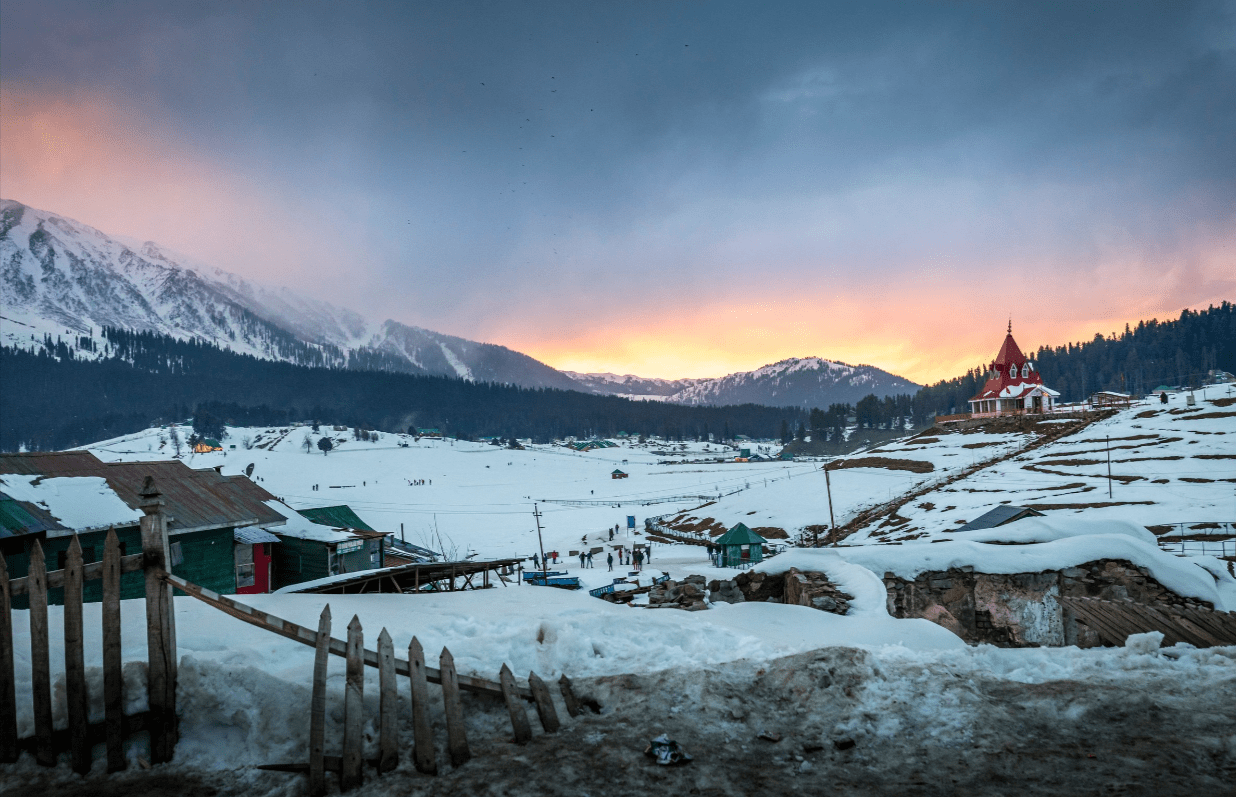Gurudongmar Lake: Incredible! Truly astonishing! Standing in front of Gurudongmar Lake left us utterly awestruck. The frigid wind and our chattering teeth only enhanced the dreamlike quality of the moment. With our faces mostly covered to shield against the fierce winds sweeping across the lake, we took in the magnificent view. Gurudongmar Lake, nestled in North Sikkim, ranks among the most striking locations in the region. Our journey to this stunning lake included visits to Lachen, Lachung, and Yumthang Valley, which perfectly complemented our itinerary.
Partially Frozen Gurudongmar Lake, Lachen, North Sikkim
In April, when we expected clear skies, we were met with unexpected heavy rain upon arriving in Lachen. For a brief time, it seemed our lake visit might be at risk. Thankfully, the rain overnight turned out to be surprisingly advantageous.
By the next morning, the weather had cleared, although the cold was still intense. We bundled up in layers of jackets and scarves. The bonus was that there were few tourists around. Although Gurudongmar Lake generally sees fewer visitors than Pangong Tso, that morning saw only four cars at the lake, an unusually low number for the season.
Location of Gurudongmar Lake
Gurudongmar Lake is among the highest lakes in India, perched at an altitude of 17,800 ft (5,340 m). This sacred site in North Sikkim lies just 5 km south of the China border and is accessible via Lachen and Thangu.
The Legend of Gurudongmar Lake
In Buddhist belief, Sikkim is referred to as Beyul Demajong, or Guru Rinpoche’s Hidden Land. Gurudongmar Lake is esteemed as one of the 108 “Tso-Chen” or major holy lakes of Demajong, believed to be the residence of local guardian deities. It is named after Guru Padmasambhava, also known as Guru Rinpoche, the founder of Tibetan Buddhism.
During the 8th century AD, Guru Rinpoche visited the Tibetan King Trisong Detsan, warning of potential threats to Tibet’s sovereignty and Buddhism. The king requested the Guru to identify places where Dharma could prosper. Following a spiritual quest, the Guru chose four sacred lands around Tibet.
His initial stop was Gurudongmar Lake in North Sikkim, followed by Tashiding in West Sikkim. Here, he discovered Beyul Demajong, hiding his treasured teachings in caves and sacred sites to be revealed when Dharma faced danger.
Legend has it that the lake remained frozen for most of the year, making it impossible for locals to access drinking water. They prayed to Guru Rinpoche for help, and he touched a part of the lake, which has remained unfrozen ever since. Gurudongmar Lake is revered as a result. Devotees believe that offering prayers and walking around the lake can bring blessings such as fertility.
North Sikkim Itinerary – Gurudongmar Lake & Yumthang Valley
- Day 1: Gangtok – Mangan – Lachen
- Day 2: Lachen – Thangu – Gurudongmar Lake – Chopta Valley – Lachung
- Day 3: Lachung – Yumthang Valley – Zero Point – Lachung – Gangtok
Sikkim remains one of our top travel destinations. Its proximity to Kolkata makes it an excellent choice for a rural escape, ideal for weekend getaways. This time, we chose to extend our stay to explore North Sikkim’s beauty.
Day 1: Gangtok – Mangan – Lachen
Our journey from Gangtok to Lachen, where your trip will likely begin, requires a permit available only through registered Sikkim travel agents. We hired a private vehicle for our three-day adventure in North Sikkim, including Gurudongmar Lake and Yumthang Valley. Solo travelers might consider joining others to reduce costs.
We departed after breakfast. Despite Google Maps estimating a 100 km drive taking 4.5 hours, road conditions extended our travel time by at least an hour. The rough roads were challenging, but the scenic stops along the way were rewarding. Our route took us through Phamtam, with a brief visit to Seven Sisters Falls—not to be confused with the falls in Cherrapunji.
Our next destinations were Mangan and Singhik Viewpoint, though the cloudy weather obscured the mountain views. We continued to Chungthang, where the road diverges towards Lachen and Lachung. We took the left turn to Lachen, around 26 km from Chungthang, which took about an hour.
The Teesta River accompanied us from Mangan to Chungthang, originating from glacial lakes like Tso Lhamo at 5,330m.
By afternoon, we reached Lachen and took a brief walk before returning to our hotel as the rain started.
Lachen
Lachen, meaning “big pass,” contrasts with Lachung, “small pass.” At 9,000 ft, the village is encircled by deep gorges and forests, with the Lachen Chu river flowing through.
In Lachen, you can visit the Lachen Monastery and the Handicraft Centre in the market area, where local artisans sell yak or sheep wool items. Unfortunately, rain kept us indoors for most of the day.
Enjoying Local Chee (Alcoholic Drink) at Lachen, North Sikkim
Lachen has small shops for snacks and drinks. We stopped at one such shop, where we ended up enjoying a bamboo glass of Chee, the local alcoholic beverage. Warming up with Chee by the fire on a cold day, while sharing stories with locals, was a highlight. Although we were the only outsiders, the locals made us feel like part of their community. Such experiences make travel so enriching.
Day 2: Lachen – Thangu – Gurudongmar Lake – Chopta Valley – Lachung
We started early, as our driver suggested (the same one who recommended Dzongu). Early departure is essential because the lake visit is restricted to the morning. The drive from Lachen to Gurudongmar Lake takes about 3.5 to 4 hours, with unpredictable weather at high altitudes.
The road from Lachen to Thangu was rough. At Thangu, the last habitation point at 13,000 ft, we found a few people in tea stalls. Despite the sunny weather, the cold was biting! We quickly had tea and continued. Other than a few tourist and army vehicles, the area was sparsely populated.
We reached Giaogong Army Checkpost at 15,000 ft, where permits are checked. You must pass this checkpoint between 7:30 AM and 10:30 AM and leave by 12:30 PM due to potential severe weather. Strong winds make it difficult to stay at Gurudongmar Lake after 10 AM. The nearby army shelter offers free tea and coffee, and there’s a souvenir shop selling mugs and holy water from the lake.
As we neared the lake, the rough, dusty road transformed into a smooth, black surface—a welcome change.
The landscape turned barren and desolate. The stark black roads cutting through this terrain, under the blue sky and soft clouds, created a stunning view. Our car navigated this stark landscape towards our eagerly awaited destination.
Roads to Gurudongmar Lake, North Sikkim
Gurudongmar Lake had been on our bucket list for a long time, and approaching it was exhilarating. Standing by the lake brought a deep sense of peace. The experience was indescribable. The partially frozen lake, adorned with colorful prayer flags fluttering in the wind, conveyed messages of peace and serenity.
The cold was severe, making it hard to keep our hands out of our pockets. Taking photos required effort! The surroundings were clean and well-maintained. There’s a staircase leading to the lake’s edge, allowing a walk around, but caution is needed due to high altitude. A small temple near the lake is attended by a caretaker.
Leaving Gurudongmar Lake
After spending some unforgettable moments at Gurudongmar Lake, we reluctantly returned to our car. While we wished we could have stayed longer, the harsh cold and strong winds made it impossible to linger. As we made our way back to Lachen, we took in the stunning views once more, knowing that this was a place we would never forget.
On the return journey, we made a brief stop at Chopta Valley, another beautiful spot in North Sikkim. The valley, with its rolling meadows and stunning views of the surrounding mountains, provided a perfect contrast to the stark beauty of Gurudongmar Lake.
Final Thoughts on Gurudongmar Lake
Visiting Gurudongmar Lake was one of the most incredible experiences of our lives. The journey, the landscape, and the spiritual atmosphere of the lake combined to create an adventure that was truly unforgettable. If you’re planning a trip to Sikkim, Gurudongmar Lake is an absolute must-visit. It’s a place that will leave you in awe and fill you with a sense of peace and wonder.
Have you had the chance to visit Gurudongmar Lake? We’d love to hear about your experience! Share your thoughts and stories in the comments below.


